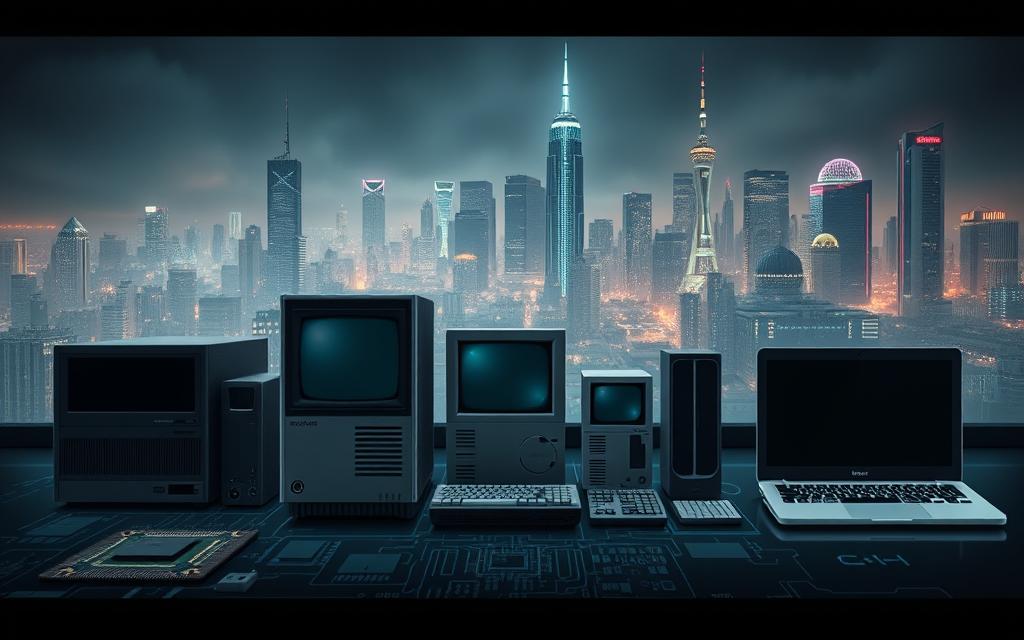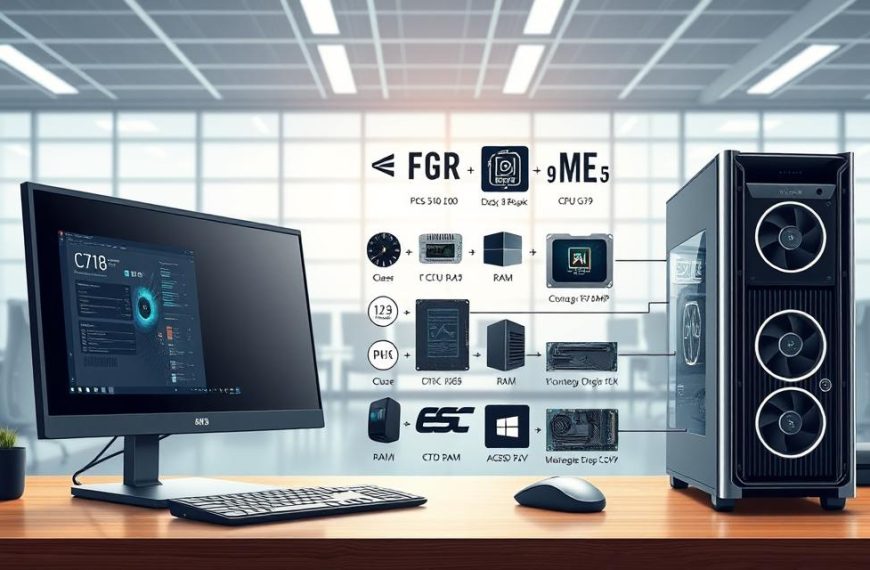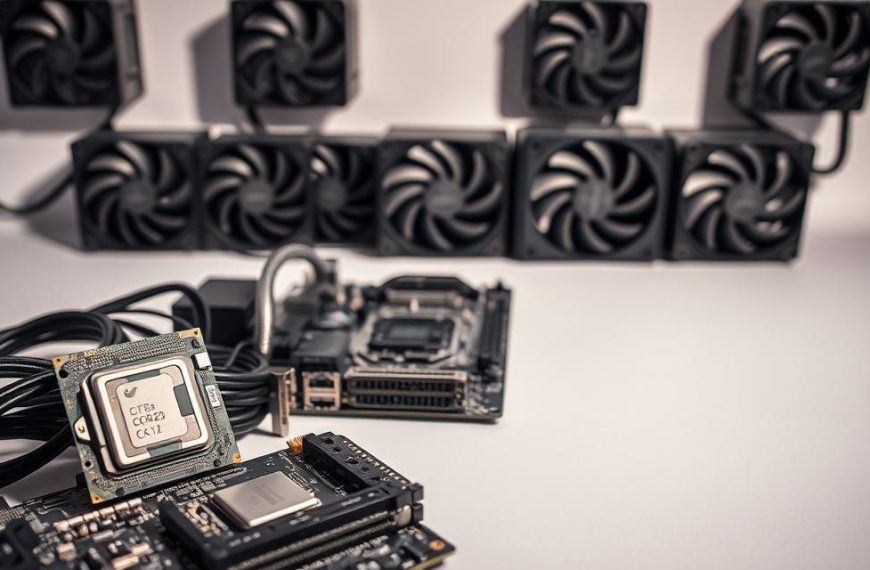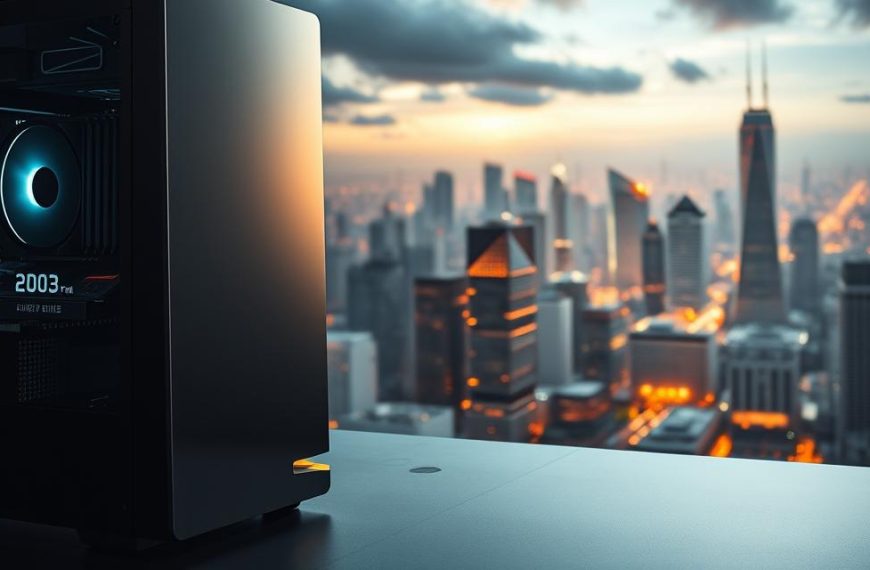Computer hardware evolution is a tale of remarkable technological progress. It’s transformed our world, from room-sized machines to pocket computers. These advancements have been truly extraordinary12.
Five distinct generations mark the journey of computer hardware. Each era brought groundbreaking innovations, spanning from the 1940s to today. This trajectory showcases incredible miniaturisation and performance gains1.
The shift from vacuum tubes to microprocessors highlights rapid technological growth. Computers have shrunk in size while dramatically increasing in power. Their efficiency has also improved significantly23.
First-generation computers used about 18,000 vacuum tubes. Now, fifth-generation systems boast millions of transistors on a single microchip. This progress shows humanity’s amazing technological capabilities12.
This computational journey offers vital insights into tech evolution. It’s driven innovation across many sectors. Moreover, it’s reshaped how we interact with digital systems3.
Understanding Computer Hardware Evolution
Computer components have transformed modern computing dramatically. From room-sized machines to pocket devices, this evolution represents a remarkable technological achievement4.
Each computer generation has improved processing capabilities and reduced physical size. Technological innovation has driven these remarkable transformations5.
Key Components in Computer Development
Critical computer components have changed significantly throughout history:
- Processors: From vacuum tubes to microchips
- Memory systems: Evolving from magnetic drums to solid-state drives
- Storage devices: Expanding from punched cards to cloud-based solutions
Timeline of Computing Advancements
Computing progress can be categorised into distinct generations, each marked by technological breakthroughs:
- First Generation (1940s-1950s): Vacuum tube era4
- Second Generation (1950s-1960s): Transistor revolution5
- Third Generation (1960s-1970s): Integrated circuit introduction
- Fourth Generation (1970s-1980s): Microprocessor development
- Fifth Generation (1980s-present): Artificial intelligence integration
Impact on Modern Technology
Modern computing has revolutionised many aspects of our lives. It has transformed communication, business, education, and entertainment5.
“Technology is best when it brings people together.” – Matt Mullenweg
Computer hardware refinement showcases humanity’s innovative capacity. It turns complex computational challenges into accessible and powerful solutions4.
What Are Five Generations of Computer Hardware
Computer generations showcase a remarkable journey of technological change. Hardware has evolved from room-sized machines to pocket-sized devices. This transformation spans distinct technological eras6.
The five computer generations highlight impressive technological advancements:
- First Generation (1940-1956): Vacuum tube technology dominated. These enormous computers consumed vast amounts of electricity7.
- Second Generation (1956-1963): Transistors replaced vacuum tubes. This change reduced machine size and boosted computational efficiency6.
- Third Generation (1964-1971): Integrated circuits emerged. They enabled more compact and powerful computing systems7.
- Fourth Generation (1971-Present): Microprocessors revolutionised computing. They integrated complex functions into single chips6.
- Fifth Generation (1980 & Beyond): This era focuses on artificial intelligence. It also explores advanced microelectronics7.
Each generation marked significant technological milestones. Computers became smaller while their processing power grew exponentially6.
This progress reflects our relentless pursuit of efficient, powerful computational technologies7.
The evolution of computer hardware demonstrates our remarkable ability to innovate and miniaturise complex technological systems.
Early Computing: Vacuum Tubes and Transistors
Remarkable technological innovations marked the dawn of computing. These innovations transformed how machines processed information. Early computer hardware underwent dramatic changes, revolutionising computational capabilities.
Vacuum Tube Technology and Limitations
Vacuum tube computers represented the first generation of computing technology from 1940 to 1956. The ENIAC computer epitomised this era, using nearly 20,000 vacuum tubes for circuitry8.
These massive machines were engineering marvels that filled entire rooms. They weighed over 30 tons and had significant limitations8.
- Enormous physical size
- High power consumption
- Limited processing capabilities
- Frequent mechanical failures
Transistor Revolution in Computing
The second generation of computers, from 1956 to 1963, marked a significant technological leap. Transistors replaced vacuum tubes, creating smaller, faster, and more reliable systems9.
In 1956, the TX-0 became the first computer to use transistor technology8. This innovation paved the way for more efficient computing.
Notable Computers of Early Generations
Several groundbreaking early computer models emerged during this transformative period. The UNIVAC I represented commercial computing applications. The IBM 1401 became widely adopted for business data processing9.
These pioneering machines laid the foundation for modern transistor-based computing. They showcased humanity’s remarkable capacity for technological innovation. Their impact continues to shape our digital world today.
Integrated Circuits and Microprocessor Era
The third generation of computer hardware revolutionised computing with integrated circuits (ICs). These compact electronic components changed computer design and manufacturing10. ICs consolidated multiple transistors onto a single chip, reducing size whilst boosting processing power11.
Minicomputers emerged, making computing more accessible to businesses and researchers. This shift from mainframes to smaller machines marked a significant technological leap10.
Key developments included:
- Reduced computer size and operational costs
- Enhanced processing speed
- Improved computational reliability
The fourth generation introduced microprocessors, revolutionising personal computing. Intel’s 4004 chip integrated entire CPU functions onto a single microprocessor11. This innovation paved the way for personal computers, transforming computing into a household technology10.
Programming languages and operating systems became more sophisticated during these generations. This made computers increasingly user-friendly and accessible to wider audiences11. The rapid technological progression set the stage for future computing innovations.
Modern Computing and AI Integration
Fifth generation computing marks a revolutionary advancement in technology. It’s driven by artificial intelligence and Ultra Large-Scale Integration (ULSI) technology12. These systems respond to natural language and have impressive self-learning abilities13.
Parallel processing is now crucial in modern computational architectures. It allows machines to solve complex problems efficiently. Google DeepMind has shown incredible potential with machine learning algorithms12.
IBM Watson showcases cutting-edge AI integration in real-world applications. It’s transforming sectors like healthcare and finance12. Tech giants are exploring quantum computing, pushing the limits of computational power12.
ULSI technology continues to shrink components while boosting processing power. These advanced systems are changing how we interact with technology. They’re creating more intuitive and intelligent computing environments13.
FAQ
What defines a generation of computer hardware?
How did vacuum tube technology impact early computing?
When did personal computing become accessible?
What role does artificial intelligence play in modern computing?
How have computer storage technologies evolved?
What are the key differences between integrated circuits and microprocessors?
How has computer programming evolved across hardware generations?
What technologies are driving the future of computing?
Source Links
- https://opentextbc.ca/computerstudies/chapter/classification-of-generations-of-computers/
- https://www.geeksforgeeks.org/generations-of-computers-computer-fundamentals/
- https://ithy.com/article/five-generation-computers-rc70kmkv
- https://ms.codes/blogs/computer-hardware/five-generations-of-computer-hardware?srsltid=AfmBOoqwfvJQJlwrqmZdzS27m7bgBUINM4W0f_bA14Z4Y-V_L4_TZQ-B
- https://www.shivajicollege.ac.in/sPanel/uploads/econtent/8480b3995ae24f1abf8b0315fd0b8050.pdf
- https://www.21kschool.com/us/blog/generation-of-computer-you-should-know/
- https://www.prepbytes.com/blog/miscellaneous/generation-of-computer/
- https://www.computerhope.com/issues/ch001921.htm
- https://www.oncrashreboot.com/computer-literacy-study-guide/the-evolution-and-features-of-computers/generations-of-computers/
- https://unstop.com/blog/generations-of-computer
- https://ms.codes/blogs/computer-hardware/five-generations-of-computer-hardware?srsltid=AfmBOopAr77SVeOWnIolmXAYoZmGVWdcsC7LrEK03cSNbWQo3fE43Y8J
- https://enozom.com/blog/generations-of-computers-a-comprehensive-overview/
- https://ms.codes/blogs/computer-hardware/five-generations-of-computer-hardware?srsltid=AfmBOorQH9v3BO2rcKbIWcoGyoq2JUNw3hiLxLlz-8KJ4lBDgSpDOH1-
















